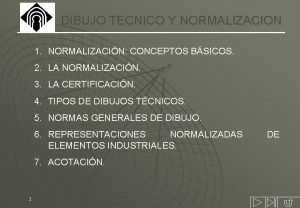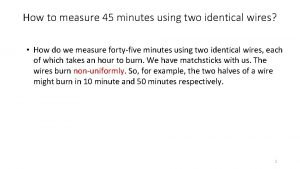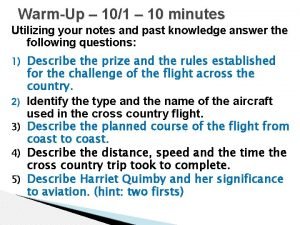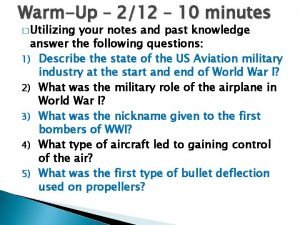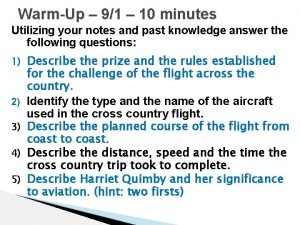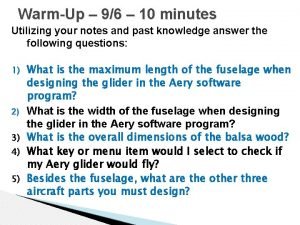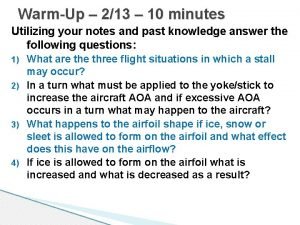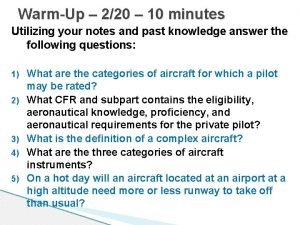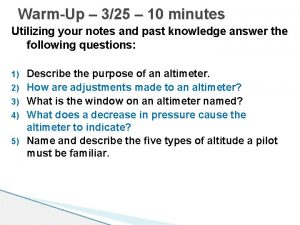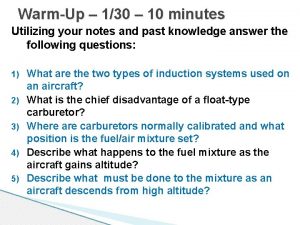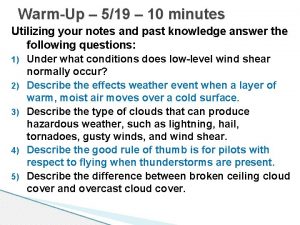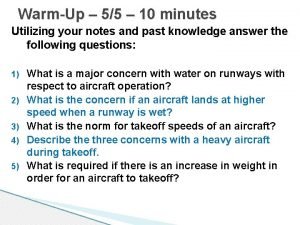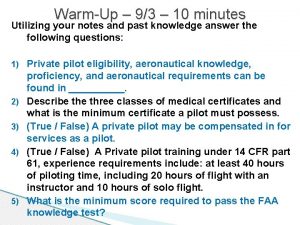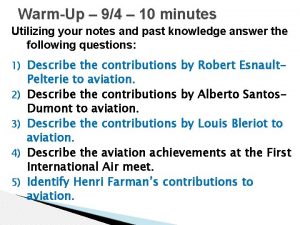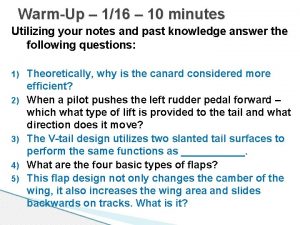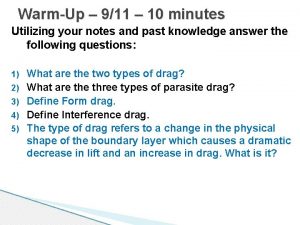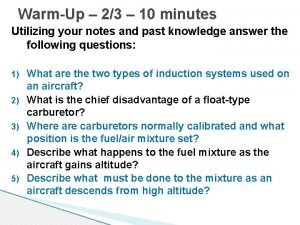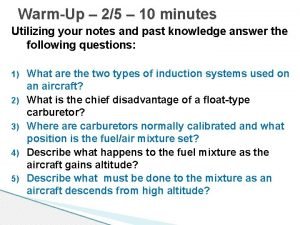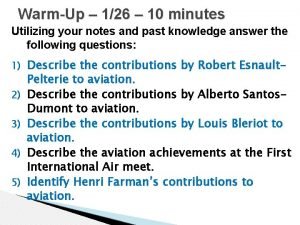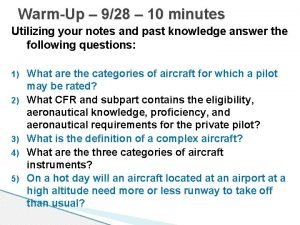WarmUp 1027 10 minutes Utilizing your notes and




















































- Slides: 52

Warm-Up – 10/27 – 10 minutes Utilizing your notes and past knowledge answer the following questions: Define static pressure. 2) Define dynamic pressure. 1)

Questions / Comments

Warm-Up – 10/27 – 10 minutes Utilizing your notes and past knowledge answer the following questions: Define static pressure. 2) Define dynamic pressure. 1)

Pitot-Static Flight Instruments Impact Pressure Chamber and Lines • Static pressure, also known as ambient pressure, is always present whether an aircraft is moving or at rest. • It is simply the barometric pressure in the local area.

Warm-Up – 10/27 – 10 minutes Utilizing your notes and past knowledge answer the following questions: Define static pressure. 2) Define dynamic pressure. 1)

Pitot-Static Flight Instruments Impact Pressure Chamber and Lines • Dynamic pressure is present only when an aircraft is in motion; therefore, it can be thought of as a pressure due to motion

Questions / Comments

THIS DAY IN AVIATION • • October 27 1909 — Mrs. Ralph van Deman flies for four minutes with Wilbur Wright at College Park, Maryland, becoming the United States' first female passenger.

THIS DAY IN AVIATION • October 27 – 2 November • 1934 — Lieut. Owen Cathcart-Jones and Kenneth H. F. Waller fly from Darwin, Australia, to Lympne, England, in 5 days 15 hours and 23 minutes, setting a new world record. (De Havilland Comet, two De Havilland Gipsy Six R engines. )

THIS DAY IN AVIATION • • October 27 1944 — The 9 th Fighter Squadron flew its first mission from the Philippines since 1942.

THIS DAY IN AVIATION • • October 27 1957 — The United States Air Force reports sending a rocket at least 1, 000 miles and perhaps 4, 000 miles above the earth at Eniwetok Atoll in “Operation Far Side. ”

Questions / Comments

October / November 2015 SUNDAY MONDAY TUESDAY WEDNESDAY THURSDAY FRIDAY SATURDAY 26 27 28 29 30 Chapter 7 Flight Instruments Altimeter Chapter 7 Flight Instruments Vertical Speed Airspeed Indicator QUIZ 1 2 3 4 5 6 7 Chapter 8 Chapter 8 Flight Instruments Gyro Systems Flight Instruments Magnetic Compass Flight Instruments Review and Test Flight Manuals Review and Test 8 9 10 11 12 13 14 Chapter 9 HOLIDAY Chapter 10 Weight and Balance Aircraft Performance 15 16 17 18 19 20 21 Chapter 10 Chapter 10 Aircraft Performance Aircraft Performance Flight Instruments 31 TEST

Questions / Comments

3 rd Semester Requirements (14 Class Meetings) • All students will complete the following: • Take notes - All In class quizzes and tests • Complete Flight Sim. Student Pilot Syllabus • Lessons 1 – 7 (Straight & Level Flight through First Solo) • Must pass written with 80% • Successfully complete 3 times on small sim • Successfully complete 1 time on Main sim • Complete ERAU Aviation 101 • 9 quizzes and 3 tests (Kut, Falcon, Not So Lonely & Relative Wind – only completers) • Student will receive zero points for all incomplete work

Questions / Comments

Chapter 7 – Flight Instruments FAA – Pilot’s Handbook of Aeronautical Knowledge

Today’s Mission Requirements • Mission: • Identify in writing how to interpret and operate flight instruments. • Describe the pilot’s ability to recognize errors and malfunctions with flight instruments. • Describe the pitot-static system and associated instruments. • Describe the vacuum system and related instruments. • Describe the gyroscopic instruments and the magnetic compass. • EQ: Describe the importance of Aeronautical Knowledge for the student pilot learning to fly.

Pitot-Static Flight Instruments Impact Pressure Chamber and Lines • Dynamic pressure is present only when an aircraft is in motion; therefore, it can be thought of as a pressure due to motion

Pitot-Static Flight Instruments Impact Pressure Chamber and Lines • The pitot tube has a small opening at the front which allows the total pressure to enter the pressure chamber.

Pitot-Static Flight Instruments Impact Pressure Chamber and Lines • The total pressure is made up of dynamic pressure plus static pressure.

Pitot-Static Flight Instruments Impact Pressure Chamber and Lines • Both openings in the pitot tube need to be checked prior to flight to insure that neither is blocked. • This helps to keep bugs and other objects from becoming lodged in the opening of the pitot tube.

Pitot-Static Flight Instruments Impact Pressure Chamber and Lines • The total pressure is transmitted to the Airspeed Indicator from the pitot tube’s pressure chamber via a small tube.

Pitot-Static Flight Instruments Impact Pressure Chamber and Lines • The static pressure is also delivered to the opposite side of the ASI which serves to cancel out the two static pressures, thereby leaving the dynamic pressure to be indicated on the instrument.

Pitot-Static Flight Instruments Impact Pressure Chamber and Lines • The two remaining instruments (altimeter and VSI) utilize only the static pressure which is derived from the static port.

Pitot-Static Flight Instruments Static Pressure Chamber and Lines • The static chamber is vented through small holes to the free undisturbed air on the side(s) of the aircraft.

Pitot-Static Flight Instruments Static Pressure Chamber and Lines • An alternate static source is provided in some aircraft to provide static pressure should the primary static source become blocked. • The alternate static source is normally found inside of the flight deck.

Altimeter • The altimeter is an instrument that measures the height of an aircraft above a given pressure level. • Since the altimeter is the only instrument that is capable of indicating altitude, this is one of the most vital instruments installed in the aircraft.

Principle of Operation • The pressure altimeter is an aneroid barometer that measures the pressure of the atmosphere at the level where the altimeter is located, and presents an altitude indication in feet.

Principle of Operation • The altimeter uses static pressure as its source of operation.

Principle of Operation • Air is denser at sea level than aloft—as altitude increases, atmospheric pressure decreases. • This difference in pressure at various levels causes the altimeter to indicate changes in altitude.

Principle of Operation • Adjustments for nonstandard pressures are accomplished by setting the corrected pressure into a barometric scale located on the face of the altimeter.

Principle of Operation • The barometric pressure window is sometimes referred to as the Kollsman window; only after the altimeter is set does it indicate the correct altitude.

Effects of Nonstandard Pressure • If altimeters could not be adjusted for nonstandard pressure, a hazardous situation could occur.

Effects of Nonstandard Pressure • For example, if an aircraft is flown from a high pressure area to a low pressure area without adjusting the altimeter, a constant altitude will be displayed, but the actual height of the aircraft above the ground would be lower then the indicated altitude.

Effects of Nonstandard Pressure • There is an old aviation axiom: “GOING FROM A HIGH TO A LOW, LOOK OUT BELOW. ”

Effects of Nonstandard Pressure • Once in flight, it is important to frequently obtain current altimeter settings en route to ensure terrain and obstruction clearance.

Setting the Altimeter • Most altimeters are equipped with a barometric pressure setting window (or Kollsman window) providing a means to adjust the altimeter.

Setting the Altimeter • A knob is located at the bottom of the instrument for this adjustment.

Setting the Altimeter • To adjust the altimeter for variation in atmospheric pressure, the pressure scale in the altimeter setting window, calibrated in inches of mercury ("Hg) and/or millibars (mb), is adjusted to match the given altimeter setting.

Setting the Altimeter • An altimeter setting is accurate only in the vicinity of the reporting station. • Therefore, the altimeter must be adjusted as the flight progresses from one station to the next.

Setting the Altimeter • Air traffic control (ATC) will advise when updated altimeter settings are available.

Setting the Altimeter • If a pilot is not utilizing ATC assistance, local altimeter settings can be obtained by monitoring local automated weather observing system/automated surface observation system (AWOS/ASOS) or automatic terminal information service (ATIS) broadcasts.

Setting the Altimeter • The importance of properly setting the altimeter cannot be overemphasized.

Altimeter Operation • When the aircraft climbs or descends, changing pressure within the altimeter case expands or contracts the aneroid barometer. • A decrease in pressure causes the altimeter to indicate an increase in altitude, and an increase in pressure causes the altimeter to indicate a decrease in altitude.

Altimeter Operation • To clear obstructions, the pilot must constantly be aware of the altitude of the aircraft and the elevation of the surrounding terrain. • To reduce the possibility of a midair collision, it is essential to maintain altitude in accordance with air traffic rules.

Types of Altitude • 1. Indicated altitude— read directly from the altimeter (uncorrected) when it is set to the current altimeter setting. • 2. True altitude—the vertical distance of the aircraft above sea level —the actual altitude.

Types of Altitude • 3. Absolute altitude— the vertical distance of an aircraft above the terrain, or above ground level (AGL). • 4. Pressure altitude— the altitude indicated when the altimeter setting window (barometric scale) is adjusted to 29. 92 "Hg.

Types of Altitude • 5. Density altitude—pressure altitude corrected for variations from standard temperature. • This is an important altitude because it is directly related to the aircraft’s performance. • The density of the air affects how much power a naturally aspirated engine produces, as well as how efficient the airfoils are.

Instrument Check • Prior to each flight, a pilot should examine the altimeter for proper indications in order to verify its validity. • Set the barometric scale to the current reported altimeter setting.

Instrument Check • If the indication is off more than 75 feet from the surveyed field elevation, the instrument should be referred to a certificated instrument repair station.

Questions / Comments
 Norma une 1032
Norma une 1032 Comp sci 1027
Comp sci 1027 Uia form 1027
Uia form 1027 Seconds in 1 hours
Seconds in 1 hours Active listening vs hearing
Active listening vs hearing Open field tackling drill
Open field tackling drill Warmup ratio
Warmup ratio Warmup 65
Warmup 65 Gmass warmup
Gmass warmup Status vs class
Status vs class Pyramid warmup
Pyramid warmup Warm rhyming words
Warm rhyming words Exponent properties
Exponent properties Java warmup
Java warmup Define:warmup
Define:warmup Ethos warmup
Ethos warmup Tom schwartz tinman
Tom schwartz tinman 65 mins
65 mins Warmup end
Warmup end Confirm your email now and get 5 minutes as a gift!
Confirm your email now and get 5 minutes as a gift! Give us your hungry your tired your poor
Give us your hungry your tired your poor Conversion notes brutes en notes standard wisc 5
Conversion notes brutes en notes standard wisc 5 Example of ideal self and actual self
Example of ideal self and actual self What does romeo overhear juliet saying
What does romeo overhear juliet saying 6 minutes 40 seconds
6 minutes 40 seconds What's half of 3 minutes
What's half of 3 minutes Your conscious awareness of your own name
Your conscious awareness of your own name I hope the days come easy
I hope the days come easy You have 30 minutes to do this task
You have 30 minutes to do this task You have 30 minutes to do this task
You have 30 minutes to do this task Types of poetry notes
Types of poetry notes Calcul de dose actrapid
Calcul de dose actrapid How to make a prescription
How to make a prescription Chemistry dimensions 2 worksheet solutions
Chemistry dimensions 2 worksheet solutions Power distance hofstede
Power distance hofstede Trevor spends 45 minutes a day in front of an intense light
Trevor spends 45 minutes a day in front of an intense light Drop factor equation
Drop factor equation Indulgence versus restraint (ivr)
Indulgence versus restraint (ivr) Reflection on lac session
Reflection on lac session Adolfo kaminsky 60 minutes
Adolfo kaminsky 60 minutes Act essay prompts
Act essay prompts Homophone of coat
Homophone of coat 1440 time management
1440 time management You only have 5 minutes left
You only have 5 minutes left You have 20 minutes to do this task
You have 20 minutes to do this task You have 20 minutes to do this task
You have 20 minutes to do this task 60 minutes eyewitness testimony
60 minutes eyewitness testimony 60 minutes recap
60 minutes recap Ruby in 20 minutes
Ruby in 20 minutes 5 minutes past the hour
5 minutes past the hour 15 minutes of reading
15 minutes of reading How to take minutes for a meeting
How to take minutes for a meeting Refomulator
Refomulator
